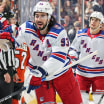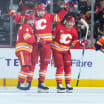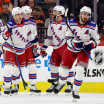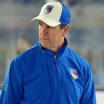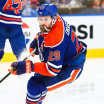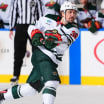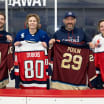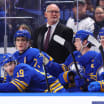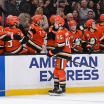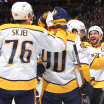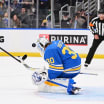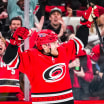Mailbag: Tarasenko's future, Devils playoff chances, rivalry games
NHL.com's Dan Rosen answers weekly questions
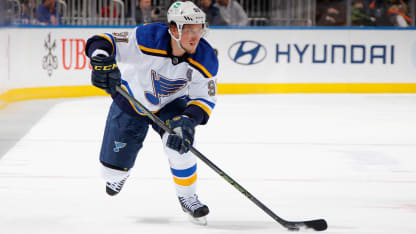
© Bruce Bennett/Getty Images
Do the St. Louis Blues still have any talks ongoing with teams about Vladimir Tarasenko? There have been mixed reports about him still wanting out but talks seem to have died completely. What are the chances he ends up with the team this year and leaves in free agency? -- @BeerLeagueSelke
It's been quiet on the Tarasenko front with the Blues, but I believe that's by design. I have zero reason to believe the trade request that he submitted before last season has been rescinded, but that doesn't mean St. Louis wants to or has to trade him. Tarasenko wasn't traded last season and he was good, piling up 82 points (34 goals, 48 assists) in 75 games to help the Blues qualify for the Stanley Cup Playoffs.
I don't think Tarasenko's value in the trade market is strong enough for the Blues to trade him now or before the season. They would have to get back a top-six forward to replace him, especially since they lost David Perron in free agency, who signed a two-year, $9.5 million contract ($4.75 million average annual value) with the Detroit Red Wings. But Tarasenko is 30 years old and entering the last year of an eight-year, $60 million contract ($7.5 million AAV). Why would a team give St. Louis one of their top-six forwards for Tarasenko when he's on the wrong side of 30 and there's no guarantees that they will have him for longer than this season? Let's not forget his history of shoulder injuries. It might be different if Tarasenko is willing to sign an extension upon being traded, but he would be doing that blindly. He has never played for another team in the NHL so I'm hesitant to think he would he marry himself to a new franchise without ever playing for them. He also might be enticed by the opportunity to become a UFA next summer.
My feeling is Tarasenko will be with the Blues this season and they will try to go on one more magical ride with him and center Ryan O'Reilly, who is 31 and is one year away from unrestricted free agency, entering the final year of a seven-year contract. It's also possible they can get one or both to sign contract extensions before or during the season.
STL@MIN, Gm5: Tarasenko records 3rd period hatty
With the offseason acquisitions and coaching staff changes along with further development of their young players, can the New Jersey Devils finally make a push for the playoffs? -- @keithcaporelli
The Devils are undoubtedly deeper and situated to be a better team with the additions of forwards Ondrej Palat and Erik Haula, defensemen John Marino and Brendan Smith, and goalie Vitek Vanecek. I love the additions of Palat and Haula. New Jersey needed more of a veteran presence in its top-nine forward group. The Devils have it with those two. Palat could be perfect for Jack Hughes. He was for Nikita Kucherov and Brayden Point when they played together with the Tampa Bay Lightning. He plays well with skilled players. With Dougie Hamilton, Damon Severson and Marino, the Devils are strong on the right side of the blue line. That buys time for
Simon Nemec
, the No. 2 pick in the 2022 NHL Draft. Smith is a versatile veteran. He'll play behind Ryan Graves and Jonas Siegenthaler, essentially buying time for
Luke Hughes
, the No. 4 pick in the 2021 NHL Draft who is expected to play one more season at the University of Michigan. Vanecek and Mackenzie Blackwood have the makings of a good goalie tandem, but neither one is a sure thing. Either way, it can't be worse than last season, when the Devils used seven goalies and the only one who had a save percentage of .900 or better was Jonathan Bernier (.902), who played 10 games, none after Dec. 3 because of a debilitating hip injury.
But to make the playoffs, the Devils have to at the bare minimum crack the top five in the Metropolitan Division, and that's only good enough if they're better than the fourth-place team in the Atlantic Division. So, are the Devils better than the Carolina Hurricanes? Hard no. Are they better than the New York Rangers? Hard no, again. Are they better than the Pittsburgh Penguins? I don't see it. Are they better than the Washington Capitals? Maybe. What about the New York Islanders and Columbus Blue Jackets? That remains to be seen. They were 18 points behind the sixth-place Blue Jackets last season. They're not better than the Lightning, Florida Panthers or Toronto Maple Leafs, the consensus top three in the Atlantic Division. I think the Boston Bruins and Ottawa Senators will battle it out for fourth place, but I'm not sold that New Jersey is better than both of those teams.
The Devils have improved this offseason and they have some star power coming with Luke Hughes, Nemec and forward Alexander Holtz. But I'm not ready to predict that they'll make the playoffs, not with uncertainty in net and the distance they have to go to be better than they were last season.
Where do you see Pat Verbeek's plan for the Anaheim Ducks going? All I know is he wants big guys. Where does he look for scoring and defensive depth? Despite the John Klingberg signing, there's still a significant gap on defense? -- @pucksngraps
There are gaps on the Ducks' depth chart that have to be filled because they're rebuilding and it's a process. Adding Klingberg on a one-year contract is big for this season. It's a trial run to see if the Ducks and Klingberg can extend the marriage for many more seasons. He turns 30 on Aug. 14. He's not too old to be a big part of the Ducks' future because they're not too far away.
Verbeek, the Ducks general manager, wants speed and strength. That doesn't have to mean big players. It does mean fast players that can compete hard on the puck. He has stated many times that he did not think the Ducks were fast enough last season. They have dynamic young players in forwards Trevor Zegras and Troy Terry, and defenseman Jamie Drysdale. They need more. Forward
Mason McTavish
could be on the opening night roster in a top-nine role. The No. 3 pick in the 2021 NHL Draft has size (6-foot, 213 pounds) and speed. He's the type of player Verbeek wants. They added forwards Ryan Strome and Frank Vatrano in free agency. That's two top-six forwards who can skate and compete hard on the puck. Strome is a playmaker. Vatrano is a shooter. They're solid additions to complement Zegras and Terry up front, just as Klingberg is on the back end to join Drysdale, Cam Fowler and Kevin Shattenkirk.
The Ducks need more players who are fast and compete hard on the puck, players who can defend well and score. They hope they have a few coming with McTavish being joined by forwards
Jacob Perreault
,
Brayden Tracey
and
Benoit-Olivier Groulx
. They need time to become NHL players and could get a chance this season.
Ryan Strome joins Anaheim
Thoughts on scheduling of rivalry games? Should some kind of favoritism be given toward rivalries or does splitting the schedule more really help grow the game/markets better? -- @mikeybox
I'm all for rivalry games, but I'm not all for too many of them. It might sound great for the Rangers and Islanders, Maple Leafs and Senators, Kings and Ducks, Flames and Oilers, Penguins and Flyers, Bruins and Canadiens, and Lightning and Panthers to play each other as many as eight or 10 times in a season, but that's too much. I'd be good with five times a season, which is at least one more time than they play now. The Rangers and Islanders play each other only three times, all by Dec. 22. That's not enough. I'm not sold that every team needs to play in every market. For example, as much as fans in Philadelphia would love to see Connor McDavid and the Oilers come to town, I think they'd be OK sacrificing that opportunity for another game against Sidney Crosby and the Penguins. Similarly, Crosby going to play in Southern California matters, but an extra Ducks-Kings game would likely entice the local fanbase more. But the NHL scheduling matrix calls for every team to play at least once home and away and the competitive balance in the League makes it tough to argue against that. Attendance figures area also strong (the NHL played to 90 percent of modified capacity last season with 20.7 million fans going to games) so clearly the current system works.


